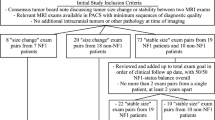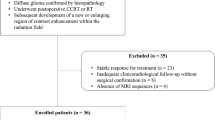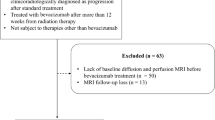Abstract
Background
Optic pathway gliomas (OPGs) are common pediatric brain tumors that pose significant clinical challenges with regard to predicting which tumors are likely to become symptomatic and require treatment. These tumors can arise sporadically or in the context of the inherited cancer predisposition syndrome neurofibromatosis type 1 (NF1). Few studies have suggested biological or imaging markers that predict the clinical course of this disease.
Objective
In this cross-sectional study, we hypothesized that the clinical behavior of OPGs in children can be differentiated by diffusion-weighted (DW) and dynamic contrast-enhanced (DCE) MRI.
Materials and methods
A total of 27 children with OPG were studied using DW and DCE MRI protocols. Diffusivity and permeability were calculated and correlated with the clinical behavior the OPG.
Results
Mean diffusivity values of 1.39 μm2/ms and mean permeability values of 2.10 ml/min per 100 cm3 of tissue were measured. Clinically aggressive OPGs had significantly higher mean permeability values (P = 0.05) than clinically stable tumors. In addition, there was a strong correlation between clinical aggressiveness and the absence of NF1 (P < 0.01).
Conclusion
These results suggest that DCE MRI might be a useful biomarker for clinically aggressive OPG, which should be confirmed in larger prospective longitudinal studies.


Similar content being viewed by others
References
Louis DN, Ohgaki H, Wiestler OD et al (2007) WHO classification of tumours of the central nervous system. IARC, Lyon, France
Friedman JM (1989) Epidemiology of neurofibromatosis type 1. Am J Med Genet 89:1–6
Friedman JM, Gutmann DH, MacCollin MM et al (1999) Neurofibromatosis, 3rd edn. Johns Hopkins Press, Baltimore
Listernick R, Louis DN, Packer RJ et al (1997) Optic pathway gliomas in children with NF1: consensus statement from the NF1 Optic Pathway Glioma Task Force. Ann Neurol 41:143–149
Listernick R, Ferner RE, Liu GT et al (2007) Optic pathway glioma in neurofibromatosis-1: controversies and recommendations. Ann Neurol 61:189–198
King A, Listernick R, Charrow J et al (2003) Optic pathway gliomas in neurofibromatosis type 1: the effect of presenting symptoms on outcome. Am J Med Genet 122A:95–99
Czyzyk E, Jozwiak S, Roszkowski M et al (2003) Optic pathway gliomas in children with and without neurofibromatosis 1. J Child Neurol 18:471–478
Shamji MF, Benoit BG (2007) Syndromic and sporadic pediatric optic pathway gliomas: review of clinical and histopathological differences and treatment implications. Neurosurg Focus 23:E3
Singhal S, Birch HM, Kerr B et al (2002) Neurofibromatosis type 1 and sporadic optic gliomas. Arch Dis Child 87:65–70
Tow SL, Chandela S, Miller NR (2003) Long-term outcome in children with gliomas of the anterior visual pathway. Pediatr Neurol 28:262–270
Adams C, Fletcher WA, Myles ST (1997) Chiasmal glioma in neurofibromatosis type 1 with severe visual loss regained with radiation. Pediatr Neurol 17:80–82
Champion MP, Robinson RO (1995) Screening for optic gliomas in neurofibromatosis type 1. The role of neuroimaging. J Pediatr 127:507–508
Brzowski AE, Bazan C, Mumma JV et al (1992) Spontaneous regression of optic glioma in a patient with neurofibromatosis. Neurology 42:679–681
Liu GT, Lessel S (1992) Spontaneous visual improvement in chiasmal gliomas. Am J Ophthalmol 114:193–201
Parazzini C, Triulzi F, Bianchini E et al (1995) Spontaneous involution of optic pathway lesions in neurofibromatosis type 1: serial contrast MR evaluation. AJNR 16:1711–1718
Shuper A, Horev G, Kornreich L et al (1997) Visual pathway glioma: an erratic tumour with therapeutic dilemmas. Arch Dis Child 76:259–263
Gutmann DH, Aylsworth A, Carey JC et al (1997) The diagnostic evaluation and multidisciplinary management of neurofibromatosis 1 and neurofibromatosis 2. JAMA 278:51–57
Ewing JR, Knight RA, Nagaraja TN et al (2003) Patlak plots of Gd-DTPA MRI data yield blood-brain transfer constants concordant with those of 14C-sucrose in areas of blood-brain opening. Magn Reson Med 50:283–292
Patlak CS, Blasberg RG, Fenstermacher JD (1983) Graphical evaluation of blood to brain transfer constants from multiple uptake data. J Cereb Blood Flow Metab 3:1–7
Chenevert TL, McKeever PE, Ross BD (1997) Monitoring early response of experimental brain tumors to therapy using diffusion magnetic resonance imaging. Clin Cancer Res 3:1457–1466
Hall DE, Moffat BA, Stojanovska J et al (2004) Efficacy of DTI-015 using diffusion MRI as an early surrogate marker. Clin Cancer Res 10:7852–7859
Moffat BA, Chenevert TL, Lawrence TS et al (2005) Functional diffusion map: a noninvasive MRI biomarker for stratification of clinical brain tumor response. Proc Natl Acad Sci USA 102:5524–5529
Gauvain KM, McKinstry RC, Mukherjee P et al (2001) Evaluating pediatric brain tumor cellularity with diffusion-tensor imaging. AJR 177:449–454
Rumboldt Z, Camacho DL, Lake D et al (2006) Apparent diffusion coefficients for differentiation of cerebellar tumors in children. AJNR 27:1362–1369
Yamasaki F, Kurisu K, Satoh K et al (2005) Apparent diffusion coefficient of human brain tumors at MR imaging. Radiology 235:985–991
Sener RN (2001) Diffusion MRI in neurofibromatosis type 1: ADC evaluations of the optic pathways, and a comparison with normal individuals. Comput Med Imaging Graph 26:59–64
Pauliah M, Saxena V, Haris M et al (2007) Improved T(1)-weighted dynamic contrast-enhanced MRI to probe microvascularity and heterogeneity of human glioma. Magn Reson Imaging 25:1292–1299
Bajenaru ML, Garbow JR, Perry A et al (2005) Natural history of neurofibromatosis 1-associated optic nerve glioma in mice. Ann Neurol 57:119–127
Law M, Oh S, Babb JS et al (2006) Low-grade gliomas: dynamic susceptibility-weighted contrast-enhanced perfusion MR imaging – prediction of patient clinical response. Radiology 238:658–667
Robinson SP, Howe FA, Griffiths JR et al (2007) Susceptibility contrast magnetic resonance imaging determination of fractional tumor blood volume: a noninvasive imaging biomarker of response to the vascular disrupting agent ZD6126. Int J Radiat Oncol Biol Phys 69:872–879
Acknowledgement
Partial support for this project was provided by Schnucks Markets Inc. to D.H.G.
Author information
Authors and Affiliations
Corresponding author
Rights and permissions
About this article
Cite this article
Jost, S.C., Ackerman, J.W., Garbow, J.R. et al. Diffusion-weighted and dynamic contrast-enhanced imaging as markers of clinical behavior in children with optic pathway glioma. Pediatr Radiol 38, 1293–1299 (2008). https://doi.org/10.1007/s00247-008-1003-x
Received:
Revised:
Accepted:
Published:
Issue Date:
DOI: https://doi.org/10.1007/s00247-008-1003-x




